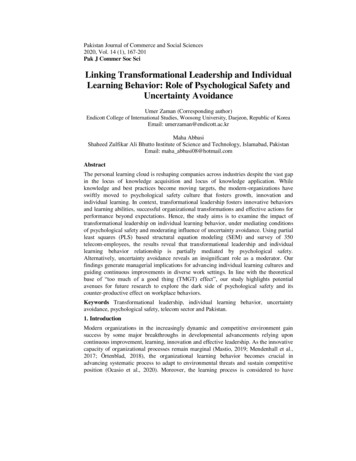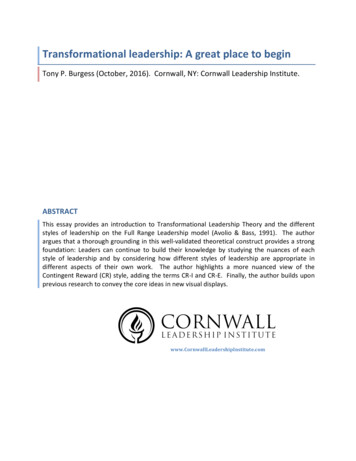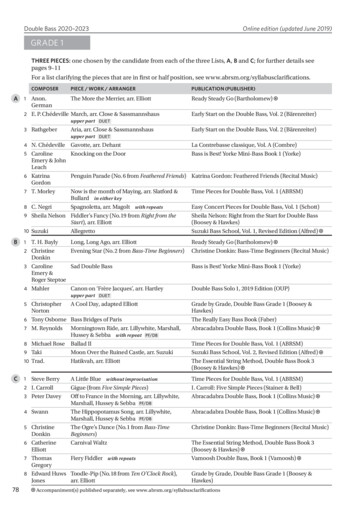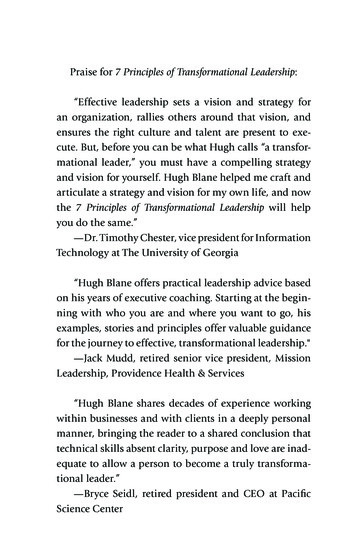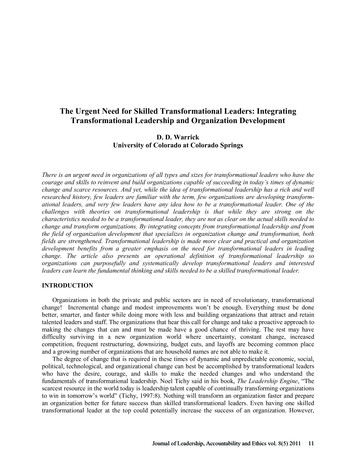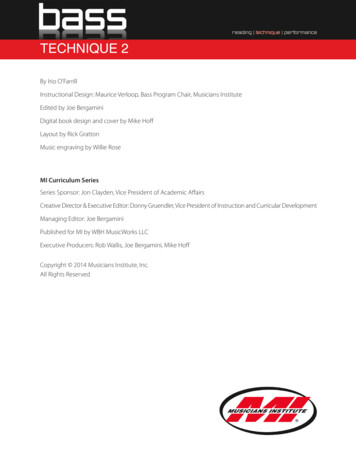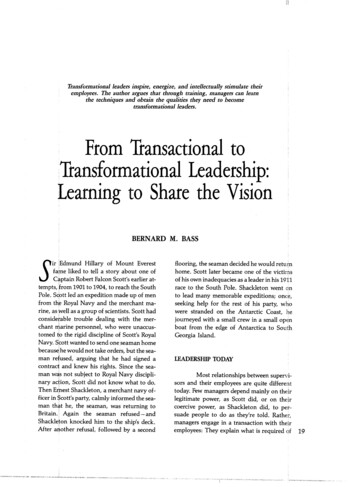
Transcription
Transformational leaders inspire, energize, and intellectually stimulate theiremployees. The author argues that through training, managers can learnthe techniques and obtain the qualities they need to becometransformational leaders.From Transactional toIransformational Leadership:Learning to Share the VisionBERNARD M. BASS ir jEdmund Hillary of Mount Everest\ fajne liked to tell a story about one of J Captain Robert Falcon Scott's earlier attempts, from 1901 to 1904, to reach the SouthPole. Scott led an expedition made up of menfrom thb Royal Navy and the merchant marine, as jwell as a group of scientists. Scott hadconsidel'able trouble dealing with the merchant n arine personnel, who were unaccustomed ip the rigid discipline of Scott's RoyalNavy. S :ott wanted to send one seaman homebecause he would not take orders, but the seaman refused, arguing that he had signed acontract and knew his rights. Since the seaman wds not subject to Royal Navy disciplinary action, Scott did not know what to do.Then Ernest Shackleton, a merchant navy officer in cott's party, calmly informed the seaman th t he, the seaman, was returning toBritain. Again the seaman refused —andShackle on knocked him to the ship's deck.After ar other refusal, followed by a secondflooring, the seaman decided he would retuijnhome. Scott later became one of the victimsof his own inadequacies as a leader in his 1911race to the South Pole. Shackleton went qnto lead many memorable expeditions; once,seeking help for the rest of his party, whowere stranded on the Antarctic Coast, hejourneyed with a small crew in a small openboat from the edge of Antarctica to SouilhGeorgia Island.LEADERSHIP TODAYMost relationships between supervisors and their employees are quite differenttoday. Few managers depend mainly on theirlegitimate power, as Scott did, or on theircoercive power, as Shackleton did, to persuade people to do as they're told. Rather,managers engage in a transaction with theiremployees: They explain what is required of 19
Bernard M. Bass is Distinguished Professor of Management and director of theCenter for Leadership Studies at the StateUniversity of New York at Binghamton. Hehas held faculty positions at the University of Rochester, the University of Pittsburgh, the University of California atBerkeley, and Louisiana State University.He is a fellow of the Academy of Management and the Society for Industrial/Organizational Psychology, executive editor ofThe Leadership Quarterly, and a memberof the executive committee of the International Association of Applied Psychologyand past president of its division of organizational psychology. Bass has performedresearch, led management developmentprograms, conducted workshops, and lectured on leadership in more than 30 countries; his books have been translated intomany languages. He has led a worldwidemanagement research and training program sponsored by the Ford Foundation.Bass holds a Ph.D. from Ohio StateUniversity. His latest work. The Bass andStogdill Handbook of Leadership (ThirdEdition) (Free Press, 1990) reviews andintegrates leadership theory, research,and applications from the social, political,and behavioral sciences.20them and what compensation they will receive if they fulfill these requirements.A shift in management style at Xerox'sReprographic Business Group (RBG) provides a good example. In the first step towardestablishing management in which managerstake the initiative and show consideration forothers, 44 specific, effective management behaviors were identified. Two factors that characterize modern leadership were found inmany of these behaviors. One factor—initialing and organizing work—concentrates on accomplishing the tasks at hand. The secondfactor —showing consideration for employees — focuses on satisfying the self-interest ofthose who do good work. The leader getsthings done by making, and fulfilling, promises of recognition, pay increases, and advancement for employees who perform well.By contrast, employees who do not do goodwork are penalized. This transaction or exchange—this promise and reward for good performance, or threat and discipline for poorperformance —characterizes effective leadership. These kinds of transactions took placein most of the effective 44 leadership behaviors identified at Xerox's RBG. This kindof leadership, which is based on transactionsbetween manager and employees, is called"transactiona! leadership."In many instances, however, such transactional leadership is a prescription for mediocrity. This is particularly true if the leaderrelies heavily on passive management-by-exception, intervening with his or her grouponly when procedures and standards for accomplishing tasks are not being met. My colleagues and I have arrived at this surprisingbut consistent finding in a number of researchanalyses. Such a manager espouses the popular adage, "If it ain't broken, don't fix it." Heor she stands in back of the caboose of a moving freight train and says, "Now I know v/herewe are going." This kind of manager may use
disciplinary threats to bring a group's performance up to standards —a technique that isineffective and, in the long run, likely to becounterproductive.Moreover, whether the promise of rewards or the avoidance of penalties motivatesthe employees depends on whether the leaderhas control of the rewards or penalties, andon whether the employees want the rewardsor fear the penalties. In many organizations,pay increases depend mainly on seniority,and promotions depend on qualifications andpolicies about which the leader has little tosay. The breaking of regulations rnay be themain cause of penalties. Many an executivehas found his or her hands tied b3 contractprovisions, organizational politics, and inadequate resources.TRANSFORMATIONAL LEADERSHIPSuperior leadership performance — transformational leadership — occurs when leadersbroaden and elevate the interests of their employees, when they generate awareness andacceptarice of the purposes and mission of thegroup, and when they stir their employees tolook beyond their own self-interest for thegood of the group. Transformational leadersachieve these results in one or more ways:They may be charismatic to their followersand thus inspire them; they may meet theemotional needs of each employee; and/orthey may intellectually stimulate employees.Exhibit 1 lists the characteristics of transformational and transactional leadership; theselistings are based on the findings of a seriesof surveys and on clinical and case evidence.Attaining charisma in the eyes of one'semployees is central to succeeding as a transformational leader. Charismatic leaders havegreat power and influence. Employees wantto identify with them, and they have a highdegree of trust and confidence in them. Charismatic leaders inspire and excite their errjployees with the idea that they may be ableto accomplish great things with extra effort.Further, transformational leaders are individually considerate, that is, they pay close atteivtion to differences among their employee?.;they act as mentors to those who need heljp'to grow and develop. Intellectual stimulatio jn.of employees is a third factor in transformational leadership. Intellectually stimulatingleaders are willing and able to show their employees new ways of looking at old problems,to teach them to see difficulties as problerqsto be solved, and to emphasize rational solutions. Such a leader was Lorenz Iversen, a.former president of the Mesta Machine Conipany, who said to his employees, "We got thisjob because you're the best mechanics in theworld!" He practiced management-by-walliing-around and stimulated the developmetjtof many of Mesta's patented inventions. He isremembered for instilling pride and commitment in his emploj es.THE BIG PAYOFFManagers who behave like transform itional leaders are more likely to be seen bytheir colleagues and employees as satisfjdngand effective leaders than are those who behave like transactional leaders, according tptheir colleagues', supervisors', and employees'responses on the Multifactor Leadership Queiitionnaire (MIQ). Similar results have beehfound in various organizational settings. Leaders studied have come from an extremelybroad variety of organizations: chief executiveofficers and senior and middle level managersin business and industrial firms in the Unite lStates, Canada, Japan, and India; researchand development project leaders; America ,Canadian, and British Army field grade offi- 21
Exhibit 1CHARACTERISTICS OF TRANSFORMATIONAL AND TRANSACTIONAL LEADERSTRANSFORMATIONAL LEADERCharisma: Provides vision and sense of mission, instills pride, gains respect and trust.Inspiration: Communicates high expectations, uses symbols to focus efforts, expresses important purposesin simple ways.Intellectual Stimulation: Promotes intelligence, rationality, and careful problem solving.Individualized Consideration: Gives personal attention, treats each employee individually, coaches, advises.TRANSACTIONAL LEADERContingent Reward: Contracts exchange of rewards for effort, promises rewards for good performance,recognizes accomplishments.Management by Exception (active): Watches and searches for deviations from rules and standards, takescorrective action.Management hy Exception (passive): Intervenes only if standards are not met.Laissez-Faire: Abdicates responsibilities, avoids making decisions.22cers; United States Navy senior officers andjunior surface fleet officers; Annapolis midshipmen; educational administrators; and religious leaders.Moreover, various types of evaluations —including performance ratings by both supervisors and direct reports, as well as standardfinancial measures — have produced a similarcorrelation between transformational behavior and high ratings. Managers tagged ashigh performers by their supervisors werealso rated, in a separate evaluation by theirfollowers, as more transformational than transactional. Their organizations do better financially. The same pattern emerged betweenfollowers' descriptions of shipboard Navalofficers and those officers' supervisors' performance appraisals and recommendationsfor early promotion. And among Methodistministers, transformational — not transactional — leadership behavior was positively relatedto high church attendance among congregants and growth in church membership.Results were the same for evaluation ofteam performance in complex business simu-lations. Considerable credit for Boeing's turnaround since its 1969 crisis can be given to itschief executive, T. A. Wilson, who has emphasized technological progress, aggressive marketing, and a willingness to take calculatedbusiness risks. The confidence that Boeingemployees have in Wilson, and their respectfor him as a brilliant engineer and an outstanding leader, have instilled in them greatpride in the company and its products.EXTRA EFFORT FROM BELOWTransformational leaders have better relationships with their supervisors and makemore of a contribution to the organizationthan do those who are only transactional.Moreover, employees say that they themselvesexert a lot of extra effort on behalf of managerswho are transformational leaders. Organizations whose leaders are transactional are lesseffective than those whose leaders are transformational — particularly if much of the transactional leadership is passive management-by- a!?w -'w3«w!ET3' '' -'". -
exception (intervening only when standardsare not being met). Employees say they exertlittle effort for such leaders. Nevertheless,leader-fdllower transactions dependent oncontingent reward may also work reasonablywell if the leaders can provide rewards thatare valued by the followers.Exhibit 2 illustrates the effect that transformational, as compared with transactional,leadership has on employee effort. The datawere collected from 228 employees of 58 managers in a large engineering firm. The managers were ranked according to their leadershipfactor scores, which were based on descriptions of leaders by their employees and colleagues on the Multifactor Leadership Questionnaire. "Four-star" leaders were those whoranked in the top 25% on a leadership factorscore; "one-star" leaders were among the bottom 25 % of managers on the leadership factor score. From 75% to 82% of the "four-star"transformational managers had employeeswho indicated they frequently exerted extraeffort on their jobs. Of the "one-star" transformational managers, only 22% to 24% hademployees who said they frequently exertedextra effort.It is interesting to note that, as Exhibit 2illustrates, being rated as "four-stcir" ratherthan "one-star" in transactional leadership didnot have the same impact on emplo ees' extraeffort as a high rating had for the transformational leaders. Similar findings have emergedfrom stxidies of leaders and their immediateemployees at a diverse range of organizations,including Digital Equipment Corporation andFederal Express.DIFFERENT STYLES OFTRANSFORMATIONAL LEADERSHIPAs noted earlier, certain types of behavior characterize the transformational leader.Yet transformational leaders vary widely intheir personal styles. H. Ross Perot is selfeffacing: "I don't look impressive," he says."To a lot of guys I don't look like I could afforda car." But Perot created the 2.5 billion ED!3organization from his vision, initiative, err phasis on hard work, and a special organizational culture with strict codes of moralit'yand dress and quasi-military management.His personal involvement in the rescue of twpof his employees trapped as hostages in Iranin 1979 is an extreme example of individualized consideration, a transformational factor.Leslie Wexner of The Limited, Inc. enjoys amore flamboyant lifestyle. But like Perot,Wexner converted his vision of a nationwidechain of women's sportswear stores into areality through his own hard work. He stimulates employee participation in discussionsand decisions and encourages them to shadehis vision of the company's future.Many on Fortune's list of the ten toughestbosses would not live up to modern behavioral science's prescriptions for the gooidlleader: one who initiates the structure for interaction among his colleagues, and who doQsso with consideration for their welfare. Nevertheless, these tough bosses are highly successful as a consequence of the transformationalqualities they display; Boeing's Wilson is jacase in point. Although they do initiate structure and may be considerate of their employees, these leaders succeed through such transformational factors as charisma and the ability and willingness to treat different subotldinates differently, as well as by providing intellectual stimulation for the employees. Theyfrequently raise standards, take calculatedrisks, and get others to join them in their vision of the future. Rather than work withinthe organizational culture, they challenge andchange that culture, as Roger Smith of General Motors Corporation did. Self-determin,ation and self-confidence are characteristic ofthem. They succeed because of these transfor- 23
Exhibit 2EMPLOYEES' EFFORTS UNDER VARIOUS LEADERSPercentage of Employees Who Exert Extra EffortTransformational "Four-Star""One-Star"ConsiderationIntellectual Stimulation"Four-Star""One-Star"] 82%Transactional LeadersContingent Reward"Four-Star""One-Star"Management by Exception"Four-Star""One-Star"60%3 58%(Percentage of employees who rate themselves3 or 4 on a 0-4 scale of extra effort.)mational elements — even if they, like Wilson,have authoritarian tendencies.TRANSFORMATIONAL LEADERS MAKETHE DIFFERENCE BETWEEN SUCCESSA N D FAILURE24Fighting with far fewer men and tanksthan his enemy had, against superior equipment, Ernst Rommel, the Desert Fox, won aseries of victories in 1941 and 1942 against theBritish in North Africa, until he was overwhelmed at El Alamein. Because he was upfront at the scene of the action, he could makemore rapid assessments and decisions thancould his British counterparts, who stayed 20miles back in headquarters. This, and his willingness to accept calculated risks, contributedto his legendary speed, surprise, and boldness, as well as to the continuing high moraleof his troops.Napoleon declared that an army of rabbits commanded by a lion could do betterthan an army of lions commanded by a rabbit. He was not far from the truth. With alldue respect to social, economic, political, andmarket forces, and to human resources policies that affect an organization's health, havinga lion —or, in Rommel's case, a fox—in command rather than a rabbit frequently meanssuccess for the organization. Lee Iacocca ofChrysler Corporation and John Welch of General Electric, who have become folk heroes (or
folk devils, to some), are contemporary examples of the importance of transformationalleaders to their organizations.Leadership makes its presence felt throughout the organization and its activities. Wehave found that eraployees not only do a better job when they believe their supervisors aretransformational leaders, but they also aremuch more satisfied with the company's performance appraisal system. Likewise, masscommunications directed toward individualemployees are much more likely to have animpact if the messages are reinforced face-toface by their supervisors at all organizationallevels.Transformational leadership should beencouraged, for it can make a big differencein the firm's performance at all levels. Managers need to do more than focus on the exchange of material,, social, and personal benefits for services satisfactorily rendered. Thecharismatic leader, like the flamboyant TedTurner of Turner Broadcasting System, Inc.can instill a sense of mission; the individuallyconsiderate leader, like the shy and self-effacing Roberto Goizueta of the Coca ColaCorporation, can lead employees to take aninterest in higher-level concerns; the intellectually stimulating leader, like the innovativeRoger Srnith at General Motors Corporation,can articulate a shared vision of jointly acceptable possibilities. This is not to say thattransformational leaders are always prosocialin their efforts, for some fulfill grandiosedreams at the expense of their followers.Despite the many successes with management development programs and the leadership development programs in our militaryacademies, many executives still jFeel thatleadership is like the weather — something totalk about, but about which not much can bedone. Others say leadership ability is mystical—one needs to be born with it.In fact, much can be done to improveleadership in an organization and to changethe presiding style from transactional to trari?;formational. The overall amount of transformational leadership in an organization can IHeincreased substantially by suitable organizgitional and human resources policies. The neivmodel of transformational leadership presents opportunities for enhancing a corporation's image and for improving its success inrecruitment, selection, and promotion. Thismodel also has implications for the organizqition s training and development activities ar dfor the design of its jobs and organizationalstructure.Implications for Corporate ImageIt is no accident that many of the firmisidentified in Tom Peters and Robert Waterman's In Search of Excellence (Warner Books,1982) as excellently managed have large nundbers of transformational leaders. Conversel]ithe poorly managed "dinosaurs" among thefirms they describe need to implement a loitmore transformational leadership. A firriiithat is permeated with transformational leadjership from top to bottom conveys to its owixpersonnel as well as to customers, suppliersi,financial backers, and the community at largtthat it has its eyes on the future; is confidentj:has personnel who are pulling together for thicommon good; and places a premium on itsintellectual resources and flexibility and oiithe development of its people.Implications for RecruitingIncreasing transformational leadershipwithin the organization may help in recruit ment. Candidates are likely to be attracted taan organization whose CEO is charismaticand enjoys a public image as a confident, suc-i 25
cessful, optimistic, dynamic leader. In addition, prospects are likely to be attracted by interview experiences with other members ofmanagement who exhibit individualized consideration. More intelligent prospects will beparticularly impressed with intellectuallystimulating contacts they make during therecruiting and hiring process.Implications for Selection, Promotion,and TransferSince we can identify and measure thefactors associated with transformational leadership, these factors should be incorporatedinto managerial assessment, selection, placement, and guidance programs — along withrelated assessments of relevant personal dimensions and individual differences. Somewhat more transformational leadership isgenerally expected and found as managersmove to successively higher levels in the organization, but it is reasonable to expect that anindividual's performance at one level will besimilar to his or her performance at the next.Direct reports, peers, and/or supervisors canbe asked to describe the manager's currentleadership with the Multifactor LeadershipQuestionnaire; their responses should be considered when decisions are made regarding amanager's promotion or transfer into a position of greater supervisory responsibility.Feedback from these results can also be usedfor counseling, coaching, and mentoring.26Further, the organization can tap the personal characteristics and strengths that underlie the manager's transformational behavior.Charismatic leaders are characterized by energy, self-confidence, determination, intellect, verbal skills, and strong ego ideals. Eachof these traits can be assessed in individualmanagers. Similarly, we can assess some ofthe traits underlyirig individualized consider-ation, such as coaching skills; preference fortwo-way, face-to-face communication; andwillingness to delegate. Again, in the area ofintellectual stimulation, candidates for promotion could be assessed with an eye towardthe type of intellectual stimulation — general,creative, or mathematical — that would bemost effective at the higher level of management. Appropriate intelligence tests may beused to select intellectually stimulating candidates.Research findings indicate that when employees rate their managers on the MLQ, theydescribe new business leaders as significantlymore transformational than established business leaders. Thus MLQ scores can be usedprofitably to identify executives to head newventures.Implications for DevelopmentA management trainee's first supervisorcan make a big difference in his or her subsequent career success. For example, six yearsafter they joined Exxon, many managers whowere highly rated by their supervisors reported that they had been given challenging assignments by their initial supervisor (i.e., theyhad received individualized consideration).Many had been assigned to supervisors withgood reputations in the firm. It is importantto note that managers tend to model their ownleadership style after that of their immediatesupervisors. Thus if more higher-ups aretransformational, more lower-level employees will emulate transformational behavior —and will be likely to act as transformationalleaders as they rise in the organization.Organizational policy needs to supportan understanding and appreciation of themaverick who is willing to take unpopularpositions, who knows when to reject the conventional wisdom, and who takes reasonable
risks. For example, when R. Gordon McGovern took over as president of Campbell Soup,he introduced the "right to fail" policy, whichshook up the stodgy organization. On theother hand, the fine line between self-confidence and obstinacy needs to be drawn. Thedetermined Winston Churchill who contributed so much to the survival of Britain inshown that leaders at all levels can be trainedto be charismatic in both verbal and nonvei bal performance. Successful programs havebeen conducted for first-level project leadersin hi-tech computer firms as well as for seniorexecutives of insurance firms.That transformational leadership can beincreased through training was verified inC(Transformational leadership can he learned,and it can—and should—be the subject ofmanagement training and development. Research has shown that leaders at all levels canhe trained to he charismatic . . !'1940 wa the same Churchill whose obstinacycontributed to the mistakes in 1941 of failingto prepare Singapore adequately and of committing British troops to unnecessary disasterin Crete iand Greece.Intellectual stimulation also needs to benurtured! and cultivated as a way of life in theorganization. The "best and the brightest"people should be hired, nourished, and encouraged . Innovation and creativity shouldbe fostered at all levels in the firm.Implicatijins for IhiiningDespite conventional wisdom to the contrary, transformational leadership is a widespread phenomenon. True, more of it occursat the tof) than at the bottom of an organization; but jit has also been observed by manyemployees in their first-level supervisors. Transformatioijial leadership can be learned, and itcan —anc should —be the subject of management traijiing and development. Research hasan experiment when Multifactor Leadershiid)Questionnaire scores were obtained on shopsupervisors from their trainees, who were intmates in minimum, medium, and maximum security prisons. The supervisors workeddirectly with the inmates in industrial shopsto produce various products for sale withinand outside the prison system. The experi ment compared four groups of supervisors oilitheir pre- and post-training effectiveness iiivarious industrial and vocational shops in theprison. One group was trained in transformzitional leadership, one group was trained intransactional leadership, one was untrainedbut measured "before and after," and one wasuntrained and measured only "after." The per Jformances of both trained grovips improved,but in comparison to the three other groupsof supervisors, those who were trained intransformational leadership did as well oi'better at improving productivity, absenteeism, and "citizenship" behavior among the inmates; they also won more respect from theinmates.27
TRAINING MANAGERSPractical training that teaches peoplehow to be transformational is similar to thatused in the Xerox RPG strategy to modifymanagement style. A counselor, mediator, orsupervisor gives a manager a detailed, standardized description of his or her transformational and transactional leadership performance as rated by the manager's employeesand/or colleagues. The Muitifactor Leadership Questionnaire is used for this purpose.The manager also sees a chart showing the effects of his or her leadership on employeesatisfaction, motivation, and perception oforganizational effectiveness. Anonymity ismaintained, although the manager sees the individual differences among the responses.Participating managers complete a parallel questionnaire about their own leadership.The discrepancies between how they ratethemselves and how their employees ratethem may be examined scale-by-scale anditem-by-item. The counselor may pose suchquestions as: "Why do you think you gaveyourself a much higher score than your employees gave you in individualized consideration?" and "Why did your employees disagreewith you on how rapidly you get to the heartof complex problems or the extent to whichthey trust you to overcome any obstacles?" Itis important for managers to be aware of andaccept their employees' view of their performance. A study of United States Naval officers found that those who agreed with theirdirect reports about their transformationalleadership behavior were also likely to earnhigher fitness ratings and recommendationsfor early promotion from their supervisors.28The manager and the counselor discuss indetail why certain results may have appearedand what can be done to improve ratings. Forexample, a manager may be asked: "Whatspecific behavior on your part makes youremployees say they are proud to work withyou?" or "What have you done that results inyour colleagues' saying you foster a sense ofmission?" The collected responses to thesequestions can create a useful picture of whatthe manager can do to raise his or her performance on particular items.In addition to working individually witha counselor, the manager also may participatein a workshop with other managers who areworking toward becoming more transformational leaders. Workshop participants whoreceived high ratings from their employees ona particular item are asked what they, the participants, specifically did to achieve these ratings. Questions might include: "Why did allof your employees say that you frequently enabled them to think about old problems innew ways?'' or "Why did they all say that youincreased their optimism for the future?'Conversely, questions may focus on whya participant's employees varied widely intheir ratings. If the data printout shoivs a widedivergence of opinion about whether a manager made the employees enthusiastic aboutassignments, he or she might be asked to suggest possible reasons for such differences ofopinion among the employees.Other Approaches to TrainingSeveral other approaches to teaching transformational leadership make use of the specific data gathered in the workshop. For instance, participants are asked to think of aneffective leader they have known and the behavior the leader displayed. Many examplesof charisma, individualized consideration,and intellectual stimulation are usually noted.The effective leaders who are mentioned typically come from many levels inside and outside the organization; the workshop leadermay point out that transformational leader-
ship is neither particularly uncommon norlimited only to world cl
Transformational leaders inspire, energize, and intellectually stimulate their employees. The author argues that through training, managers can learn the techniques and obtain the qualities they need to become transformational leaders. From Transactional to Iransformational
